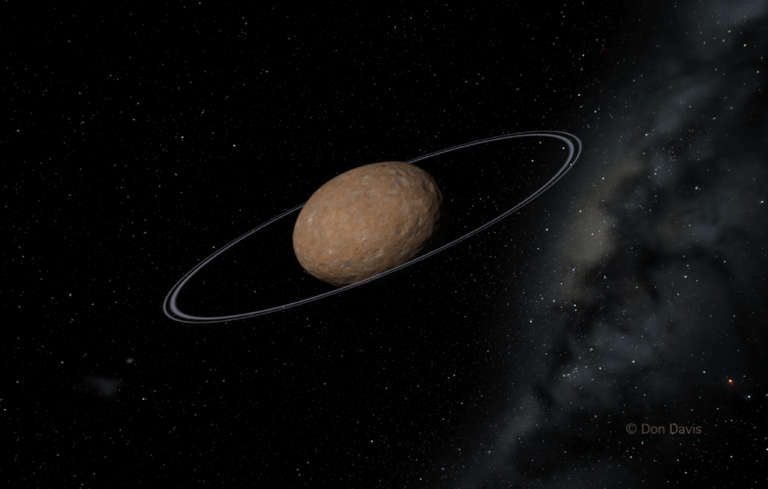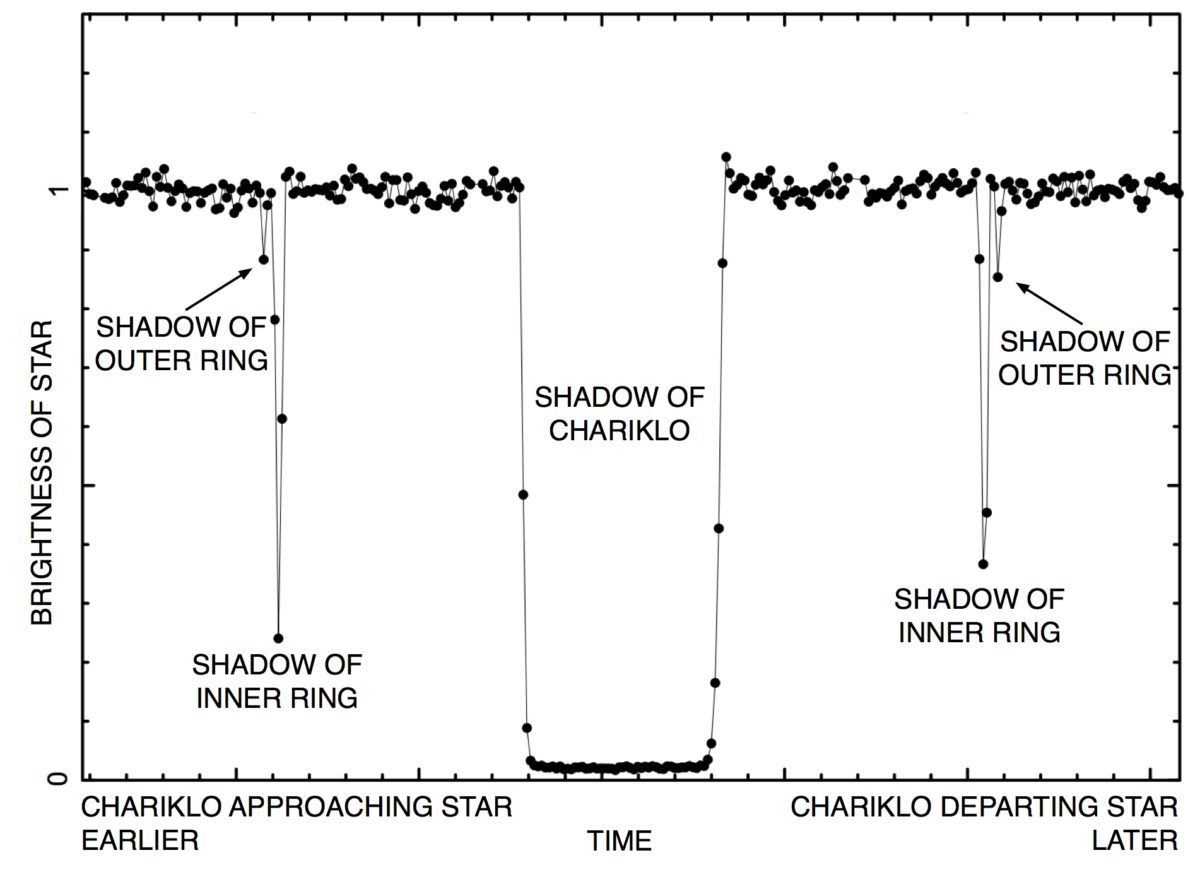Alex Parker • Mar 27, 2014
A Centaur’s shadow reveals bright rings
In 1610, Galileo Galilei first observed Saturn’s ring system through his modest telescope. Saturn remained the only planet known to host rings until 1977, when James Elliot, Edward Dunham, and Douglas Mink discovered the ring system of Uranus. They did so not as Galileo did — who saw Saturn’s rings in reflected light — but rather by detecting the rings’ effect on the light of a background star. Aboard the Kuiper Airborne Observatory, they watched the light from a bright star as Uranus drifted in front of it, with the goal of studying the properties of Uranus’ atmosphere by analyzing the starlight that was filtered through it. To their surprise, they noticed that before and after the planet dimmed the light of the star, the star “blinked” several times, as if blocked by narrow, partially-opaque structures moving in concert with Uranus. These structures were identified as a series of narrow rings circling the planet.

Since then, rings have been discovered around Jupiter and Neptune, leaving every giant planet in our solar system clad with rings. Despite substantial search efforts, no natural rings have ever been detected around any of the terrestrial planets.
Yesterday, another team of astronomers announced that they discovered a very similar set of rings with the same technique. However, these rings are not around a giant planet in our solar system or another, nor even a major planet at all. They are hosted by the Centaur Chariklo, an asteroid-like body that currently resides in the unstable region between the orbits of Saturn and Uranus.
Like Uranus, these rings were spotted when Chariklo was observed passing in front of a bright star. A network of telescopes deployed across South America where turned to witness the event, called a “stellar occultation,” with hopes of accurately measuring the size and shape of Chariklo by measuring the size and shape of its shadow as it swept across the continent. Unexpectedly, before and after Chariklo’s shadow reached many of the telescope sites the star was seen to rapidly blink twice.


In a paper published today in the journal Nature, lead by astronomer Felipe Braga-Ribas, these events were shown to be the flickers created by the passing shadows of two narrow rings about Chariklo. This is an unprecedented discovery; while Chariklo is the largest known Centaur, it is only 250 kilometers across, with a surface area comparable to the state of Texas. A giant planet it is not, and yet like a giant planet, it hosts a system of rings!
Given its large average distance from Earth, Chariklo is too small to appear as anything but a moving point of light in any of today’s best instruments. Without the fine details provided by the occultation observations, it is likely that Chariklo’s rings would never have been discovered.

By modeling the observations from seven different observatories that successfully observed the occultation event, the astronomers determined that the rings orbit at almost exactly one Chariklo diameter above its surface. They are narrow (a few kilometers wide each), close to one another (with a inter-ring gap of only 8 km), and dense, rendering the innermost ring over 30% opaque.
A Centaur Between Giants
The spaces between the major planets are occupied by a variety of populations of minor planets. Between Mars and Jupiter lies the Main Asteroid Belt; leading and trailing Jupiter are the Jovian Trojan swarms. Exterior to Neptune lies the Edgeworth-Kuiper Belt, where Pluto resides. The spaces between the orbits of Jupiter, Saturn, Uranus, and Neptune are populated by the unstable Centaurs, which filter in from exterior to Neptune and are buffeted around by the giant planets’ gravity fields until either becoming comets or being ejected outward once again. These bodies are small, asteroid-like, and icy in composition.

While the Centaur Chariklo currently resides on an orbit between Saturn and Uranus, it likely originated further out in the Edgeworth-Kuiper Belt before close encounters with the giant planets emplaced it on its current orbit. It is still subjected to close encounters with the giant planets, and its days in its current orbit are numbered; on timescales of order tens of millions of years it will likely be ejected from this region of space by its interactions with Uranus.
Short-lived or Shepherded?
Chariklo’s rings are narrow, confined to just a few kilometers in width. In the absence of active shepherding, planetary rings will spread due to collisions between ring particles. Given the altitude of Chariklo’s rings and the size of Chariklo itself, its rings should spread out beyond their current extent in matters of a few thousand years, unless there are small, as-yet-unseen moons there to guide the rings. Such shepherd moons have been seen in planetary ring systems like Saturn’s and Uranus’. According to the analysis presented by Braga-Ribas and co-authors, shepherd satellites only a few kilometers in radius would be sufficient to sustain the features observed in Chariklo’s rings. Such satellites would be extremely faint and close to Chariklo, and would be extremely difficult to detect on their own.
Origin and Survival of Rings
At first glance, it might not seem unusual to find rings around objects like Chariklo. Centaurs and Kuiper Belt objects are known to frequently exist in binary systems, and the destruction or cratering of a binary companion could produce ring material. In fact, this fact caused a great deal of concern when the small satellites of Pluto were first identified; impacts could dredge up material from these small moons and produce rings of debris that could be dangerous for New Horizons during its flyby of the system. An extensive effort was made to identify any such hazards in the Pluto system, and to date none have been found — much to the relief of the New Horizons team!
Yet finding this pair of rings around Chariklo was a shock to many planetary scientists. Many other asteroids and Edgeworth-Kuiper Belt objects have been studied in similar occultations, and none of them have showed unambiguous evidence of long-lived rings; that the first rings to be seen around an asteroid-like object would look so much like the rings of a giant planet — well-defined, dense, closely-spaced, and icy — is a surprise, and may indicate that ring formation is more generic and robust than perhaps assumed. The origin of Chariklo’s rings and their architecture will likely be a question hotly pursued by dynamicists in the coming months. Collisions between moons or other bodies passing through Chariklo’s region of space could produce the icy debris that makes up in the rings, but such a collision would have to occur at a low velocity for the ring structure to form. Braga-Ribas and co-authors suggest that this is more likely to have occurred while the object was still in the Edgeworth-Kuiper Belt, before it became a Centaur. Because Chariklo’s rings are so close to its surface, they are relatively tightly-bound to it, and it would take extremely close flybys of the giant planets to damage them; thus, the rings could likely survive the transition from the Edgeworth-Kuiper Belt into the Centaur region.
Odd Behavior Explained
The authors note that Chariklo had exhibited strange trends between 1997 to 2008; dimming slowly and showing ever-decreasing quantities of water ice in its spectrum. They demonstrate that an ice-rich ring system would neatly account for this; the rings would have appeared edge-on from Earth in 2008, and would have appeared their dimmest then, causing the combined light of Chariklo and its rings to dim as it did. If the rings are water-rich, they would contribute a water-ice component to Chariklo’s spectrum, but this would also fade as the rings moved toward an edge-on configuration in 2008.
Takeaway
There are now five worlds in the entire Universe confirmed to host systems of rings; in order of discovery, Saturn, Uranus, Jupiter, Neptune, and Chariklo. One ring system has been detected around a low-mass object orbiting another star — 1SWASP J140747.93-394542.6 — but it is unclear if these rings circle a massive planet or a low-mass star. Finding a ring system around a small world like Chariklo was unexpected and demonstrates how diverse the minor planets in our solar system are. We have recently witnessed minor planets collide with one another, sprout plumes of water, rip themselves apart by spinning too quickly, and now host planet-like systems of rings.
Asteroids, Centaurs, and Edgeworth-Kuiper Belt objects are demonstrating that they are complex and dynamic worlds in their own right. Next year we visit two dwarf planets for the first time; Dawn will reach Ceres in the asteroid belt, and New Horizons will reach Pluto on the fringes of the Edgeworth-Kuiper Belt. Given the surprises we’ve been given lately by worlds smaller than these, I can only imagine what remains in store for us just around the corner.
Support our core enterprises
Your support powers our mission to explore worlds, find life, and defend Earth. You make all the difference when you make a gift. Give today!
Donate

 Explore Worlds
Explore Worlds Find Life
Find Life Defend Earth
Defend Earth

